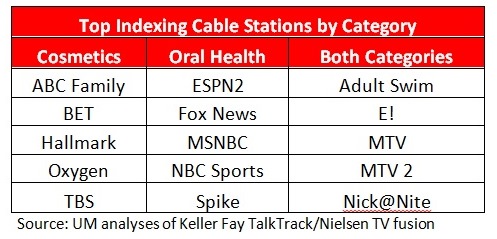Why Social TV May Be in Danger of Becoming Predictable – Graeme Hutton

Thankfully, the advertising industry, particularly TV selling and buying, recently received a major shot in the arm from a joint-research initiative by Nielsen TV and the Keller Fay Group which enables us to consider less obvious and more bespoke solutions. This initiative is a fusion of Nielsen TV panel’s ratings data with Keller Fay’s word-of-mouth tracker. The result is that we now have marketing category-specific rankers of 100+ broadcast and cable TV channels and many more shows highlighting which stations and programs have an above-average, or below-average, proportion of active category brand talkers. The fusion has over 50 market categories from foreign vs domestic car marque talkers, to hotel vs cruise line brand talkers, to at least seven types of retail-category brand talkers. UM became the first agency subscriber.
Although Social TV is barely four years old, television program selection for Social TV may be in danger of becoming predictable and unimaginative. When the industry talks about Social TV we tend to focus on three areas:
1. Tentpole Events, e.g. the Super Bowl, The Oscars.
2. Larger Reality Shows, e.g. “American Idol” and “The Voice.”
3. Genre-specific programming: for men sports such as football, and for women female-oriented dramas such as “Pretty Little Liars” and “Teen Wolf.”
For anyone actively involved in Social TV marketing, this is a list of the usual and the obvious. While these shows can produce highly effective word-of-mouth marketing solutions, if all brands simply focused on this finite number of programs, the range of creativity and market availability could rapidly become constricted.
A Major Research Initiative from Nielsen and Keller Fay
Thankfully, the advertising industry, particularly TV selling and buying, recently received a major shot in the arm from a joint-research initiative by Nielsen TV and the Keller Fay Group which enables us to consider less obvious and more bespoke solutions. This initiative is a fusion of Nielsen TV panel’s ratings data with Keller Fay’s word-of-mouth tracker. The result is that we now have marketing category-specific rankers of 100+ broadcast and cable TV channels and many more shows highlighting which stations and programs have an above-average, or below-average, proportion of active category brand talkers.
The fusion has over 50 market categories from foreign vs domestic car marque talkers, to hotel vs cruise line brand talkers, to at least seven types of retail-category brand talkers. UM became the first agency subscriber.
One of the key findings that impressed me about this fusion is that different market categories can exhibit quite diverse stations and program solutions. One way to demonstrate this is to compare the top indexing stations of two relatively similar categories to determine what they may have in common but also, what differences or distinctions may exist.
Top Indexing Shows Vary By Category
In this example, let’s look at top cable stations for the macro category of personal care and appearance, and focus on two subcategories: cosmetics and oral care. By cosmetics, we mean talkers of brands such as Revlon and Cover Girl and, for oral care, Crest or Colgate. From 100+ cable stations, we could summarize the top indexing networks as follows:

The overall characteristics of leading stations for each category are noticeably quite different. Networks which are notably strong in the oral care sector tend to be male and older, stations with a more general family and female appeal are more likely to do better in cosmetics, and channels which are younger and more effervescent appeal to both brand talkers of both market categories. The detail from this type of network segmentation output enables TV planners and buyers to assess which stations and programs, both cable and broadcast, offer the best targeting opportunities to match the needs of a particular campaign.
Campaign Activation Has To Extend Beyond Ad Creative Messaging
As I have mentioned in previous columns , any form of TV word-of-mouth marketing is often strongest when the ad campaign is activated, via promotions and sponsorships etc., and where it also offers an element of difference, surprise or distinct newsworthiness. Anyone relying solely on the advertising’s creative messaging alone to achieve the campaign’s ambitions is leaving at least half the campaign’s potential success on the drawing board. Yet by harnessing this type of data, the TV planner and buyers can determine which TV networks to approach to develop the necessary favored-nation trading arrangement to ensure the most vibrant, integrated word-of-mouth campaigns.
Overall, I think there is a potential, three-way win-win with this welcome research initiative:
1. Marketers can create distinctive WOM marketing strategies for brands within their portfolio and versus competitors.
2. Agencies can develop unique WOM-centric solutions that can boost campaign reach, and
3. Media owners can offer diverse added-value solutions for each of their TV properties.
Graeme Hutton is SVP, Group Partner, Research at UM. Graeme came from the UK to the US in the late 90s, and his only regret is that he did not do it sooner! Graeme joined UM in 2006. At UM, he has engineered and activated a broad-based set of integrated communications and consumer insight tools which dovetail into the agency’s burgeoning arsenal of media research products and systems. Graeme can be reached at Graeme.hutton@umww.com
late 90s, and his only regret is that he did not do it sooner! Graeme joined UM in 2006. At UM, he has engineered and activated a broad-based set of integrated communications and consumer insight tools which dovetail into the agency’s burgeoning arsenal of media research products and systems. Graeme can be reached at Graeme.hutton@umww.com
Read all Graeme's MediaBizBloggers commentaries at Curious Thoughts from Curious Minds.
Check us out on Facebook at MediaBizBloggers.com
Follow our Twitter updates at @MediaBizBlogger
The opinions and points of view expressed in this commentary are exclusively the views of the author and do not necessarily represent the views of MediaBizBloggers.com management or associated bloggers. MediaBizBloggers is an open thought leadership platform and readers may share their comments and opinions in response to all commentaries.


